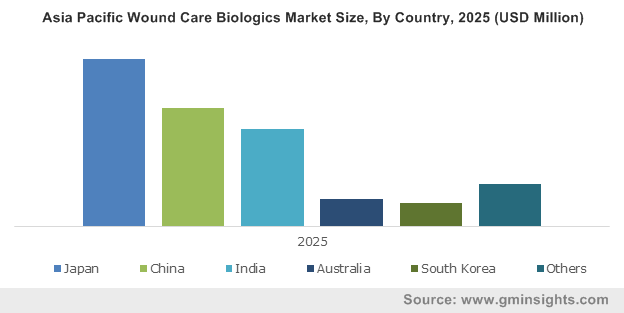Home > Healthcare > Pharmaceuticals > Finished Drug Form > Wound Care Biologics Market
Wound Care Biologics Market Analysis
- Report ID: GMI2925
- Published Date: Jan 2019
- Report Format: PDF
Wound Care Biologics Market Analysis
Skin substitutes segment was valued at USD 940.6 million in 2018. Bioengineered skin and substitutes demand in surgeries has been growing in recent years. Also, recent advancements in skin tissue engineering have elevated its adoption amongst the doctors performing surgical procedures escalating the segmental growth. Bioengineered skin and substitute are one of the useful tools in reconstructive surgery practices prominently used as an alternative to skin grafts. For instance, allogenic acellular dermal matrix has high preference in the breast reconstruction procedures. Also, acellular dermal matrix products are utilized in diabetic-lower extremity ulcers. High usage of such superior bioengineered skin and soft in aesthetic procedures will drive the segmental growth during the forecast period.
Topical agents’ segment will experience 8.9% CAGR during the forecast timeframe. Increasing demand for skin reconstruction and other aesthetic surgeries will drive the demand for topical agents. Phases of tissue repair are generally controlled by active topical agents. Also, topical agents have a vital role in tissue bio-engineering and are extensively preferred during the trauma cases that positively impacts the segmental growth.
Diabetic foot ulcers segment accounted for 16.8% in 2018 and is expected to show similar growth trends over the upcoming years. Diabetic wounds are caused due to high sugar levels that usually lead to hormonal imbalance and give rise to diseases such as chronic foot ulcers. As reported by OxyGeneration, of the total people suffering from diabetes at least 15%-20% will suffer from foot ulcers. Generally, clinicians prefer wound care biologics that provides moist environment for wound healing. Therefore, high usage of wound care biologics in treatment of diabetic wounds will augment the segmental growth.
Pressure ulcer segment will experience 10.2% CAGR during the forecast timeframe. Increasing prevalence of pressure wounds such as bed sores will positively impact the demand for wound care biologics. Patients struggling with chronic diseases such as diabetes often have slower healing rates and are prone to bed sores. Also, patients with bone disorders are bed ridden and often suffer from bed sores. Moreover, pressure ulcers include serious complications such as cellulites bacteremia sepsis and septic arthritis that further stimulates the demand for wound care biologics escalating the segmental growth.
Hospitals segment was valued at USD 665.5 million in 2018 and is expected to have substantial revenue size during the forecast timeframe. Significant revenue size can be attributed to the increasing use of wound care biologics in treating patients suffering from diabetic foot ulcers, pressure ulcers and skin burns. Moreover, high usage of allografts and other skin substitutes in the treatment of post-surgical wounds will flourish the segmental growth in forthcoming years.
Ambulatory surgical centers segment accounted for 31.5% revenue share in 2018. Ambulatory surgical centres can offer lower-priced procedures as they have a lower cost structure compared to traditional hospital setting. Though the cost structures are low, the operational efficiencies are uncompromised that increases their preference. Moreover, ASCs are generally located in the suburbs and rural areas that provides patients with better access that should positively impact the segmental growth.
U.S. wound care biologics market will experience 8.8% CAGR and is expected to grow substantially during the forecast timeframe. High growth can be attributed to the increasing perveance of diabetic foot ulcers. According to Azura Vascular Care, around 10% of people suffering from diabetes acquire chronic foot ulcers. Wound healing process is slow in patients with diabetes as the oxygen doesn’t reach most of the cells in the body that increases the chances of susceptibility for microbial and fungal skin infections. Moreover, growing preference for skin substitutes in aesthetic surgeries will augment the U.S. wound care biologics market growth during forecast timeframe.
India wound care biologics market was valued at USD 55.3 million in 2018. Growing number of burn cases will favor the India wound care biologics market growth. Third-degree burns are generally treated with skin grafts and bio-engineered skin tissues that enables quicker recovery. Moreover, growing geriatric population will positively impact the industry growth over forthcoming years.


